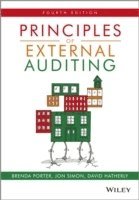
- Format
- Häftad (Paperback / softback)
- Språk
- Engelska
- Antal sidor
- 896
- Utgivningsdatum
- 2014-02-07
- Upplaga
- 4 ed
- Förlag
- John Wiley & Sons Inc
- Medarbetare
- Porter
- Illustratör/Fotograf
- Illustrations
- Illustrationer
- Illustrations
- Dimensioner
- 241 x 170 x 48 mm
- Vikt
- Antal komponenter
- 1
- Komponenter
- 1667:Standard B&W 6.69 x 9.61 in or 244 x 170 mm (Pinched Crown) Perfect Bound on White w/Gloss Lam
- ISBN
- 9780470974452
- 1476 g
Principles of External Auditing
- Skickas från oss inom 5-8 vardagar.
- Fri frakt över 249 kr för privatkunder i Sverige.
Passar bra ihop
De som köpt den här boken har ofta också köpt Slow Productivity av Cal Newport (häftad).
Köp båda 2 för 1051 krKundrecensioner
Fler böcker av författarna
-
Pieminister
Jon Simon, Tristan Hogg
A stunning recipe book with easy-to-follow recipes, beautiful photography, charming good-humour and a wealth of information around the history of the pie from award-winning Pieminister - the creation of Tristan Hogg and Jon Simon - who have led th...
-
The Failure and the Future of Accounting
David Hatherly
In The Failure and the Future of Accounting, David Hatherly rethinks accounting in the light of a financial crisis which exposed its limitations. He reminds us that in the run up to 2008 the accounts of financial institutions reported increasing p...
Övrig information
Brenda Porter is Head of School of Accounting and Law at Victoria University, Wellington New Zealand. Jon Simon is Lecturer in Accounting & Finance at the University of Hull Business School David Hatherly is Professor of Accounting at the University of Edinburgh Management School.
Innehållsförteckning
About the Authors xi Preface xiii Structure of the Financial Reporting Council xvii Glossary of Terms xix 1 What is Auditing? 1 1.1 Introduction 1 1.2 What is an audit? 2 1.3 Types of audit 3 1.4 Auditing vs Accounting 8 1.5 Why are external fi nancial statement audits needed? 8 1.6 Benefi ts derived from external fi nancial statement audits 11 1.7 Summary 18 Self-review questions 18 References 19 Additional reading 20 2 The Development of Auditing and Its Objectives 23 2.1 Introduction 23 2.2 Overview of the development of company auditing 23 2.3 Development of auditing in the period up to 1844 26 2.4 Development of company auditing 18441920s 27 2.5 Development of company auditing 1920s1960s 32 2.6 Development of company auditing 1960s1990s 36 2.7 Development of company auditing 1990spresent 39 2.8 Summary 51 Self-review questions 52 References 53 Additional reading 55 3 A Framework of Auditing Concepts 57 3.1 Introduction 57 3.2 Social purpose, postulates and framework for concepts of auditing 59 3.3 Concepts relating to the credibility of auditors work 60 3.4 Concepts relating to the audit process 70 3.5 Concept relating to auditors communication: reporting 86 3.6 Concepts relating to the standard of auditors performance 90 3.7 Summary 94 Self-review questions 95 References 95 Additional reading 98 4 Threats to, and Safeguarding of, Auditors Independence 99 4.1 Introduction 99 4.2 Threats to auditors independence 100 4.3 Steps taken by parliament and regulators to safeguard auditors independence 104 4.4 Other proposals to strengthen auditors independence 140 4.5 Role and responsibilities of audit committees 143 4.6 Summary 151 Self-review questions 152 References 153 Additional reading 157 5 Auditors Legal, Regulatory and Professional Responsibilities 161 5.1 Introduction 161 5.2 Reporting and auditing requirements of companies 165 5.3 Appointment, remuneration and removal of company auditors 181 5.4 Auditorclient relationship 189 5.5 Auditors duties and rights 191 5.6 Audit fi rms transparency reports and governance code 207 5.7 Summary 211 Self-review questions 212 References 213 Additional reading 216 6 Auditors Duties with Respect to Fraud and Non-compliance with Laws and Regulations 217 6.1 Introduction 217 6.2 Defi nition of fraud 218 6.3 Development of auditors responsibility to detect and report fraud 220 6.4 Auditors current responsibilities to detect and report fraud 229 6.5 Aggressive earnings management 241 6.6 Auditors responsibility to detect and report non-compliance with laws and regulations 242 6.7 Auditors duty of confi dentiality to their clients 250 6.8 Summary 253 Self-review questions 254 References 255 Additional reading 257 Appendix: Examples of fraud risk factors 258 7 Overview of the Audit Process, Audit Evidence, Staffing and Documenting an Audit 261 7.1 Introduction 261 7.2 Overview of the audit process 262 7.3 Clarification of some jargon 265 7.4 Audit evidence 271 7.5 Staffi ng an audit 277 7.6 Documenting an audit 289 7.7 Summary 306 Self-review questions 307 References 309 Additional reading 310 8 Commencing an Audit: Engagement Procedures, Understanding the Client and Identifying Risks 311 8.1 Introduction 311 8.2 Pre-engagement investigation 312 8.3 Audit engagement letters 320 8.4 Understanding the client, its business and its industry and how it evaluates its performance 325 8.5 Identifying and assessing risks of material misstatement in the financial statements 332 8.6 Analytical procedures 336 8.7 Summary 340 Self-review questions 341 References 342 Additional reading 342 9 Planning the Audit; Materiality and Audit Risk 345 9.1 Introduction 345 9.2 Phases of planning an audit 346 9.3 Impact of materiality on planning an audit 350 9.4 De
Du kanske gillar
-
48 Laws of Power
R Greene
HäftadTransformed
Marty Cagan
Inbunden


